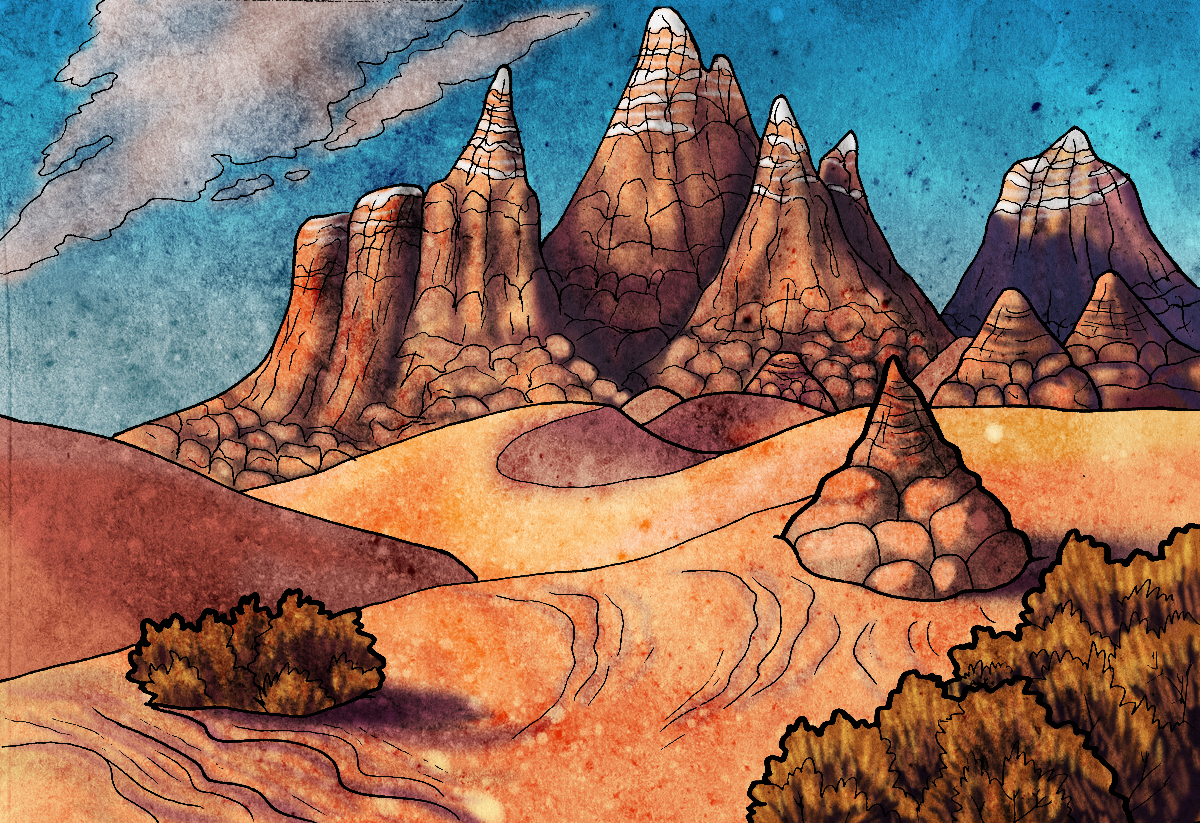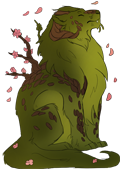Tokopedia
Go to Search
Original location inspiration by Sullyhound and legacv
Original location art by AnimalArtKingdom
Phantom’s Fingers
Fosbir
Windy and cold at the peaks even in the deepest heat of the summer. Very arid with very little precipitation. The skies are almost always clear and blue, save for the days howling sandstorms blot out the sun. If it does get a bit of snow at its top, it is blown into crevices and hidden away in the shadows of the rocky spires. Lower down the sides of the mountain, it becomes a little more hospitable to heat-adapted wildlife and scraggly trees, but drought conditions are the norm. Frequent landslides cause the landscape to seem disjointed with large swathes of disruption and regrowth.
Description:
A windy and treacherously jagged mountain easily recognizable from miles around as a distinct landmark for its weathered top that some say resembles fingers or claws reaching toward the sky. The constant winds have worn away much of the soil exposing beautiful colored striations of rock. Sometimes a bit of white snow can be seen in the cold of winter glimpsed between the crags. For a very brief time in early spring, the lower flanks of the mountain can be seen carpeted in greens and wildflowers if there is any rain. They are unclimbable, with relentless and unpredictable wind gusts, along with unstable rocky terrain throughout.Landmarks:
- Phantom's Claws - The mountain itself is the major landmark of the area and everyone knows of it. Some locals refer to it as the Phantom's Claws, or just “the Claws”.
- Pitsakol’s Folly - A deceptively sloped hillside below the higher jagged rocks. Temporarily grows vegetation in early spring if there are any rains, luring creatures and people alike to its abundance only to have frequent rock slides and falling debris make it a lethal destination. It looks like it will be easy to climb in this location until it slides you down the side of the mountain without warning.
- The Old Trail - The remnants of a winding possibly man-made trail that makes its way about halfway up the north face of the mountain before abruptly ending at the edge of a sharp chasm. It is not safe and not frequently used but still referenced by locals. The name implies there is a newer path. There is not.
- The Maw - The largest, deepest cavern yet found in this desert. Often compared to a gaping maw. Sometimes, when explorers rappel down to investigate, their partners don't pull them back up--just a rope that looks bitten off.
- The Ancient Warren - At the foot of the mountain is a vast plain of red sedimentary rock, smooth and hilly from eons of wind erosion. The most notable feature--thousands of holes and tunnels, ranging from the size of a snake den to a ground sloth burrow. Some are so short and shallow you can stick your arm in and see your hand on the other side. Others lead deep underground, seemingly with no end. Explorations have revealed that many of them are interconnected, with chambers resembling an ancient warren.
Lore:
- There is a legend that the region of Fosbir used to be so hot the land itself was like molten lava, and great terrible beasts wreaked havoc on the land and anything that tried to live there. A menacing beast with grasping fingers would reach out and grab unsuspecting creatures or plants, along with anything that tried to take root or settle the wild land. Nothing could grow and the land was in chaos. Then a gentle and determined deity who could carry the gift of water came forth to battle the great beasts. The deity was able to bring peace with a tidal wave of cool water, turning the shifting land to stone and stopping one of the clawing creatures mid-swipe. It is said you can still find the bones and fossils of great beasts and plants the phantoms dragged down if you dig in this region.
- The Old Trail? It’s said a mining expedition once ventured partway up the side of the north face to survey a deep crevasse following rumors of a hidden spring with gold in it. The unfortunate members of this party soon discovered there was no mythical spring, no gold, and no way out of the sheer-sided crevasse that blocked the path. All the local old-timers have their own versions of this doomed tale and lack of survivors.
- There are different theories as to how the warrens formed. One local favorite is that the tunnels were made by an ancient colony of some giant animal, not unlike the ground sloth. Another is that evil spirits burrow and hide here, which is what really makes the place so eerie, not the noise. Yet another is that the ocean that deposited the rock layers made natural divots in the ground which the wind eroded over the eons into tunnels.
Original location inspiration by Sullyhound and legacv
Original location art by AnimalArtKingdom

